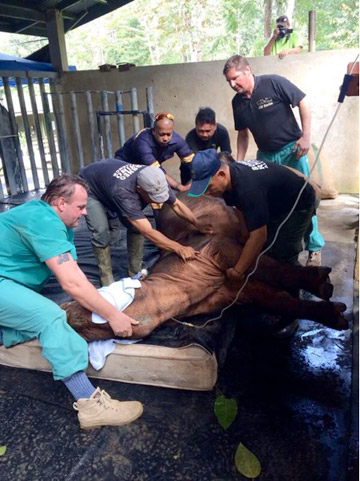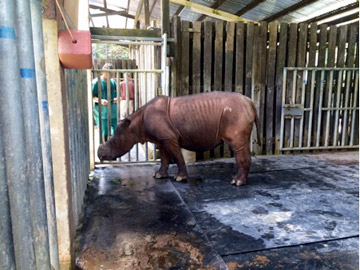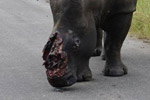Conservation for Sumatran rhinos suffered another blow last week, only days after Suci—one of only ten rhinos in captive breeding efforts—died at Cincinnati Zoo. Scientists in the Malaysian state of Sabah revealed that a newly captured female, Iman, suffers from an assortment of tumors in her uterus, hugely complicating reproduction efforts. Conservationists believe less than a hundred Sumatran rhinos survive today on the island of Borneo and Sumatra after being pushed to extinction everywhere else.
“What we found out today was a dramatic emotional rollercoaster,” said IZW reproductive specialist, Thomas Hildebrand, with the Leibniz Institute for Zoo and Wildlife Research (IZW). “We came here with hope that based on initial ultrasound images there was a probability that Iman was pregnant but when we did a more thorough examination we learnt that there is no fetus in her uterus but big big tumors, some as big as footballs. This means that she has not been sexually active for a long time probably without a male partner for maybe five to ten years.”
Iman is currently housed at the as-yet unfinished Borneo Rhino Sanctuary in Sabah. Conservationists hoped to breed her with resident male, Tam, but will now turn to more drastic measures.
 Iman being put on a mattress to be further examined via ultrasound after being anesthetized. |
“It is very clear how we need to proceed. We have to embark on a biotechnology approach to save this species, with a focus on techniques such as in vitro fertilization,” said Laurentius Ambu, Director of Sabah Wildlife Department.
The center is already home to another female, Puntung, who also suffers from an intractable uterus filled with cysts, likely due to a failed pregnancy in the past. Puntung is also missing a foot, probably lost to a poacher’s trap.
“The reproductive tract pathology in Iman seems very similar to the lesions found not only in Puntung, the other female Sumatran rhino rescued in 2011, but also in the poached female rhino in Kalabakan in 2001. The poached female rhino was a very young healthy female but her whole reproductive tract was unviable and full of large tumors as well,” explained Sen Nathan, Assistant Director at the Sabah Wildlife Department. “By the looks of this we might be seeing the last generation of Sumatran rhinos in the wild. Once these few grow old and die…that’s it, there would be no more rhinos in Sabah.”
Still, conservationists believe they are doing the best thing by taking remaining Sumatran rhinos out of the wild into controlled, albeit large sanctuaries, where breeding—either natural or through new technologies—can occur. The strategy has had its success: a pair of rhinos at the Cincinnati Zoo produced three rhinos (one of which was newly-deceased Suci), while a baby rhino was born as recently as 2012 in Way Kambas Rhino Sanctuary on Sumatra.
Yet ongoing progress has been frustrating slow and stymied by a lack of cooperation according, John Payne, the head of the Bornean Rhino Alliance (BORA).
“Even at this stage, Governments of Indonesia and Malaysia are not collaborating, while the world specialists in captive rhino breeding in USA and Germany are not talking to each other. It is long overdue that they must do so,” he said. “We should now think seriously in terms of bringing Sumatran rhinos together in large, fenced, managed facilities, perhaps on a specially-managed area of non-government owned farm land. This is how the African rhinos and two bison species were saved from extinction a century ago.”
 Iman fully recovered from her anesthesia after the ultrasound procedure. |
In fact, last year conservationists held a summit on the species and agreed that international cooperation—including mixing subspecies (one found in Sumatra and the other in Borneo)—would be required to save the species from extinction. Yet those working with the rhinos are not fully living up to the agreement said Cynthia Ong, the head of Sabah-based NGO LEAP (Land Empowerment Animals People).
“One of the key things we decided together at the Sumatran Rhino Crisis Summit was to treat all the remaining individual rhinos as a united population entrusted to all of us, instead of belonging to different governments, research or conservation groups. But we seem to be failing the species because too often it seems we still find real transparency and collaboration harder than rhetoric, cloaking, posturing and stone walling,” she told mongabay.com.
Today nine Sumatran rhinos are in captivity (one in Cincinnati Zoo, three in Sabah, and five in Sumatra). Experts expects only a few wild individuals remain in Borneo, while the bulk of the wild population is scattered between several protected areas in Sumatra.
Ong adds that she remains concerned about the direction of these last-ditch conservation efforts.
“The closer we get to the utter failure of extinction the more we are drawn to solutions in which the rhinos are the passive recipients of our technological interventions,” she said. “Whatever solutions we end up using I believe success requires we first strengthen our commitment and ability to listen to the species with the humility required of the newly evolved species trying to partner with a group that has been around 25 million years or more.”
Sumatran rhinos are the smallest, hairiest, and oldest evolutionary of the world’s remaining rhinos. The only surviving member of the genus Dicerorhinus, the Sumatran rhino is believed the be related to the extinct woolly rhino. It is considered one of the world’s most endangered mammals.
Related articles
Death of young Sumatran rhino shouldn’t discourage captive breeding efforts say conservationists

(04/01/2014) Just over two weeks ago, conservationists in the Malaysian state of Sabah managed to finally catch a wild Sumatran rhino female after months of failed attempts. But following such hopeful events, comes bad news thousands of miles away: a young female rhino, named Suci, died over the weekend at the Cincinnati Zoo.
Meet Iman: the Sumatran rhino’s newest hope for survival

(03/24/2014) Hopes for one of the world’s most imperiled megafauna rose this month when wildlife conservationists succeeded in catching a female Sumatran rhino named Iman in the Malaysian state of Sabah. The female, which experts believe to be fertile, has since been successfully transferred via helicopter to the Borneo Rhino Sanctuary where experts plan to mate her with the local male, Tam. Located in Tabin Wildlife Reserve, the Borneo Rhino Sanctuary is an uncompleted semi-wild enclosure and home to one of several last-ditch efforts to save the vanishing species from extinction.
Howard G. Buffett puts $24M toward saving rhinos
(03/21/2014) Howard G. Buffett, the son of Berkshire Hathaway chairman Warren Buffett, has pledged $23.7 million to South African National Parks to help fight rhino poaching in Kruger National Park, reports Reuters.
Conservationists catch wild Sumatran rhino, raising hope for world’s most endangered rhinoceros

(03/12/2014) Conservationists have succeeded in catching a wild Sumatran rhino in the Malaysia state of Sabah in Borneo, according to local media reports. Officials are currently transferring the rhino, an unnamed female, to a rhino sanctuary in Tabin National Park where experts will attempt to mate it with the resident male, Tam. The Sumatran rhino (Dicerorhinus sumatrensis) is one of the world’s most imperiled species with less than 100 individuals left.
Rhino with bullet in its brain and hacked off horn wanders for days before being put down

(03/05/2014) Last week, visitors in Kruger National Park came on a horrifying sight of the poaching trade: a rhino, still alive, with its horn and part of its face chopped off. The gruesome photo of the young rhino went viral and sent South African authorities scrambling. Five days after the sighting, South African National Parks (SANParks) has announced they found the rhino and put it out of its misery.
Javan rhino population jumps by over 10 percent
(03/04/2014) The Javan rhino population has increased by over ten percent from 2012 to last year, according to new figures released by Ujung Kulon National Park. Using camera traps, rangers have counted a total of 58 Javan rhinos, up from 51 in 2012. Although the species once roamed much of Southeast Asia, today it is only found in Ujung Kulon National Park in western Javan and is known as one of the most imperiled mammals on the planet.
South Africa loses nearly 150 rhinos to poachers so far this year
(02/28/2014) Since the first of the year, South Africa has lost 146 rhinos to poachers or approximately 2.5 rhinos every day. This is a slight dip from last year’s poaching rate, which hit 1,004 for the whole year or 2.75 a day. South Africa is home to more rhinos than any other country on the planet, but the populations have been hit hard by poachers in recent years seeking rhino horn.